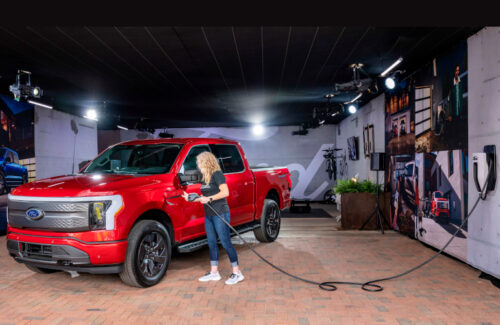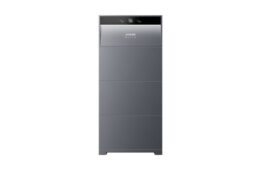Bells and whistles are great, but sometimes the basic model is all that’s needed for energy storage.
When solar customers and power-concerned homeowners aren’t interested in or able to take advantage of load-shifting and demand arbitrage opportunities managed by energy storage systems, there are simpler products available today just for emergency backup. No longer do contractors have to suggest a gas generator or a bank of lead-acid batteries; many companies offer portable and powerful lithium-ion systems that can support customers looking for peace of mind during a blackout.
This category of energy storage is often referred to as “solar generators” and has been mostly marketed to adventurers on the go — those camping, traveling, tailgating and working off-grid. These battery systems have lower capacities than stationary residential systems like the Tesla Powerwall and LG RESU, but they are expandable for specific power needs. They can be charged by portable solar panels or through the grid. Depending on the source of charging electricity, solar generators can be very clean. And best of all, they can be used to back up appliances and loads in the home at a fraction of the price of a stationary system.
Here are a few portable energy storage systems and solar generators that are increasingly being looked at for emergency backup in the home.
Goal Zero Yeti
Likely the most popular portable lithium battery system comes from Goal Zero. The company’s Yeti 6000X Portable Power Station has an initial capacity of 6.071 kWh and uses NMC batteries with a 500-cycle lifespan at 80% depth of discharge (DoD). Yeti 6000X has 2 kW of continuous power and 3.5 kW of surge power. The station has seven output ports, but it can also be connected to a home’s electrical panel to support four essential circuits.
While Yeti 6000X is the company’s most powerful starting unit, Goal Zero offers many setups to accommodate various power needs. Customers just need one Goal Zero power station as a base, and then storage capacity can be expanded through cheaper lead-acid battery add-ons. Because of their size and weight, the lead-acid batteries are stationary, while the lithium power station is portable. The Yeti Tank Expansion Batteries come in a pair for 2.4 kWh of additional power capacity.
Not an especially common setup, Goal Zero can combine lithium and lead-acid battery technologies through its Yeti Link Expansion Module — essentially, a sophisticated battery management system.
“Our expansion tank is a deep cycle, lead-acid battery. This allows you to use the electronics in the Yeti [lithium-based system] but expand the battery,” said Bill Harmon, GM at Goal Zero. “You can add as many [lead-acid batteries] as you want. The customer can just plug them in. Suddenly, you have the portability of the lithium battery and the inexpensive lead-acid batteries sitting at home.”
Harmon told Solar Power World that Goal Zero has recently seen “almost an even split” between customers buying Yeti systems for home backup vs. outdoor recreation, but more than 70% indicate they intend to use the systems for both purposes.
“Our system is for all the people in the country who don’t have $15,000 to spend on an energy storage installation. And then when I’m done, all I have is something permanently installed in my home,” Harmon said. “Yeti is for those who are sensitive to what they’re spending money on.”
The Yeti 6000X is advertised online at under $6,000 with each two-battery lead-acid expansion priced under $1,300.
Renogy Lycan 5000
Renogy, an energy product provider for the DIY crowd, released the Lycan 5000 Power Box in 2021, a 4.8-kWh lithium battery system specifically designed for emergencies, power outages and off-grid homes. Lycan can be expanded up to 19.2 kWh, and the LFP batteries have a 4,500-cycle lifespan at 80% DoD. With the help of a licensed electrician, Lycan can be connected to a building’s main electrical panel.
Renogy reps told Solar Power World that while Lycan is a portable unit (it’s attached to wheels and is rated for outdoor use), most customers are just using it for emergency backup.
“Most customers use Lycan as their source of power generator via solar,” the rep said. “When used in home situations, customers install a sub-panel to divert part of their home’s appliances to be supported by Lycan instead of the grid.”
The 4.8-kWh unit has a continuous power output of 3.5 kW and a peak power output of up to 7 kW, with AC outlets directly on the system. It is equipped with circuit breakers and surge protection devices.
One additional benefit of the Lycan: It does not require a permit to install if it is used for a fully off-grid situation.
The system is advertised online at under $5,200.
Bluetti EP500
Bluetti, an off-grid power solutions company, has a line of solar generators and its own portable home battery backup system. The Bluetti EP500 Solar Power Station is a 5.1-kWh system on wheels, and its LFP batteries have a 3,500-cycle lifespan at 80% DoD. Two units can be connected for up to 10.2 kWh of capacity. One EP500 has a 2-kW continuous power output rating with a peak of 4.8 kW.
A licensed electrician can connect the EP500 to a building’s main electrical box through the Bluetti Sub Panel.
A portion of the user’s manual does show how roof-mounted solar panels can charge the station, as long as they do not use microinverters. EP500 comes with its own sine inverter, so that panel-level inversion would not work with the system.
The system is advertised online at under $4,600.
Growatt Infinity 1500
Growatt, a company largely known for its residential inverter line, also has a portable power system that boasts 12 outlets. The Infinity 1500 has an initial capacity of 1.554 kWh but can be expanded up to three units for 4.662 kWh of total storage power. The NMC batteries have an 800-cycle lifespan at 60% DoD. Infinity 1500 is rated at 2-kW of continuous power output with a 4-kW surge.
In addition to grid and solar charging capabilities, Growatt has the option for the Infinity 1500 to be charged through an EV charging station.
Infinity 1500 is currently only available in the United States, but Growatt has not yet begun shipping the product. No pricing information is listed at this time.
Ford F-150 Lightning
 Maybe one of the more interesting “portable” lithium battery systems that recently hit the market is the 131-kWh battery in the new all-electric Ford F-150 Lightning truck. By using a bidirectional charger, the truck’s big battery could provide three full days of emergency backup, based on average home consumption.
Maybe one of the more interesting “portable” lithium battery systems that recently hit the market is the 131-kWh battery in the new all-electric Ford F-150 Lightning truck. By using a bidirectional charger, the truck’s big battery could provide three full days of emergency backup, based on average home consumption.
The F-150 Lightning hit the road over the summer, with solar installer Sunrun working as the preferred installer of its home charging solutions. California utility PG&E is testing Ford’s Intelligent Backup Power bidirectional charging capabilities as on-demand power sources for homes.
Sunrun public relations senior manager Wyatt Semanek said it’s still too early to know if customers are buying the Ford F-150 Lightning for emergency backup, but he did say that initial order data does suggest that consumers are eager to use the bidirectional charger in their homes.
“The size — roughly 10 Powerwalls — and capability of the battery, plus the utility of a truck, makes it a very attractive backup alternative,” Semanek said.
With the successful operation of Ford’s Intelligent Backup Power system, it could more quickly open the door to other bidirectional charging efforts from companies like Wallbox and Emporia, and lead to more EVs being used as standby backup power.









Performance of Renogy Lycan 5000 in your article is very great, Jim Carr provide feedback from Amazon:Very pleased with the quality and performance of this product. For a battery it stores an impressive amount of power that lets you charge electronics, run modest appliances, and keep some lights on during a power failure. And if you live outside of major cities in the northeast you know that’s becoming more of a problem. Not sure yet if this will run my gas furnace blower, but it keeps on the pilot and runs the blower in my gas fireplace insert. This is a good backup if you live in an apartment, condo or townhouse and can’t have a generator.
Again, here is a sign that TESLA may be the first name off someone’s tongue, there are many others with a focus on portability and function. Yeah, TESLA has a way to go to compete with these guys.
You might also highlight EcoFlow. Their DeltaPro delivers up to 3600 W with 3600 Wh. They can be combined for 240V support and they have a Smart Home Panel to provide seamless backup as well as time shifting for loads. I have two DeltaPros and at this very minute they are providing backup for my home through a planned power outage 🙂
Lots of great points Kelly but I would like to add that these are mainly consumer or residential grade solar generators. There are companies like ours, New Use Energy, and others that are developing professional grade solar generators and solar UPS’s. A lot of the use cases beyond home conveniences, are in disaster or humanitarian relief, construction, telecoms, events etc that are being addressed by weatherized tough solar generators.
They also need to work with real solar arrays for fast solar recharging. Our company’s equipment is being used in front line hospitals in Ukraine for example, running full surgery rooms. Often after disasters there are many left living in temporary shelters where they need power from that generator for 6-12 months. Let me know if you want to know more about where solar generators go beyond camping and temporary home power.
I thank you know what you’re talking about and I would love to know more. When I was about 17 years old,I worked for a battery company Red Diamond Battery Co. I worked on a acid Iine and one of my jobs was filling the batteries with acid cleaning the batteries and charging them on a heavy wooden cart. You would put about 20 per top and 20 on bottom, then we would hook the first positive to the negative on the second and so on until it completes the circle until there is one positive on the front and one single negative,And put the single positive hooked to the charger system and the the negative to the
Negative and If I remember right the next day we would pack and ship makes me wonder how many volts were in the first two. When they were hooked together.